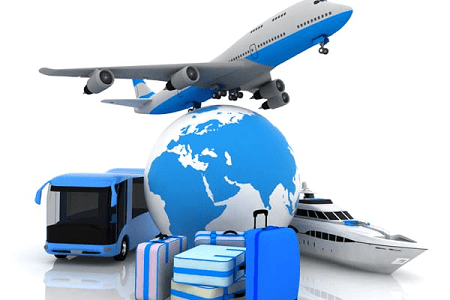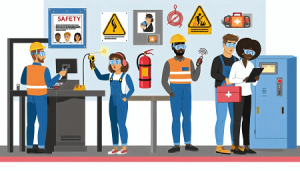Tourist transport travel trade-
The tourist transport and travel trade industry encompasses various modes of transportation and services that cater to the needs of tourists. It is a critical component of the broader tourism industry, facilitating the movement of tourists from their home locations to their destinations and within those destinations. Here are some key aspects of the tourist transport and travel trade:
1. Modes of Tourist Transport
- Air Travel: Airlines play a significant role in long-distance travel, connecting tourists to international and domestic destinations. Major hubs and low-cost carriers contribute to accessibility.
- Rail Travel: Trains offer a scenic and often more relaxed mode of travel, with some routes specifically designed for tourists, such as luxury trains or scenic railway journeys.
- Road Travel: Buses, coaches, and rental cars provide flexibility and convenience, especially for group tours or destinations not easily accessible by air or rail.
- Water Travel: Cruise ships, ferries, and boats are popular for coastal and island destinations, offering unique travel experiences.
2. Travel Trade Services
- Travel Agencies: These entities assist tourists in planning and booking their trips, including flights, accommodations, tours, and other travel-related services.
- Tour Operators: They organize and package holiday tours, often providing all-inclusive deals that include transport, accommodation, meals, and guided tours.
- Online Travel Agencies (OTAs): Platforms like Expedia, Booking.com, and Airbnb facilitate the booking of various travel services through the internet.
- Destination Management Companies (DMCs): These are local experts who provide in-depth knowledge and logistical support for tourists at specific destinations.
3. Trends in Tourist Transport and Travel Trade
- Technology Integration: Mobile apps, online booking systems, and digital payments have revolutionized the industry, making it more accessible and efficient.
- Sustainable Travel: There is a growing emphasis on eco-friendly travel options, including electric vehicles, sustainable aviation fuels, and green certifications for travel businesses.
- Customization and Personalization: Travel experiences are increasingly tailored to individual preferences, with customized itineraries and personalized services.
- Health and Safety: Post-pandemic, there is a heightened focus on health protocols, safety measures, and travel insurance to ensure the well-being of tourists.
4. Challenges in the Industry
- Environmental Impact: The industry faces pressure to reduce its carbon footprint and promote sustainable practices.
- Regulatory Issues: Different countries have varying regulations, which can complicate international travel and transport operations.
- Economic Fluctuations: The travel trade is sensitive to economic changes, which can affect tourists’ spending power and travel behavior.
- Technological Disruptions: Rapid technological advancements require continuous adaptation and investment from industry players.
5. Future Prospects
- Innovative Transport Solutions: The development of high-speed trains, hyperloop systems, and autonomous vehicles could revolutionize tourist transport.
- Virtual and Augmented Reality: These technologies can enhance the travel planning process and offer virtual tours of destinations.
- Smart Destinations: The use of IoT and smart technologies to improve tourist experiences and manage destination resources efficiently.
Understanding these aspects of the tourist transport and travel trade industry can help businesses and policymakers make informed decisions to enhance tourist experiences and ensure sustainable growth in the sector.
What is Required Tourist transport travel trade
The required elements of the tourist transport travel trade encompass various factors essential for ensuring a seamless and enjoyable travel experience for tourists. These elements include:
1. Accessibility
- Transport Options: Availability of diverse modes of transport (air, rail, road, water) to cater to different preferences and needs of tourists.
- Infrastructure: Adequate infrastructure such as airports, train stations, roads, and ports to facilitate smooth movement of tourists.
2. Safety and Security
- Safety Measures: Implementation of stringent safety protocols across all transport modes to ensure the well-being of tourists.
- Security: Measures to protect tourists from risks such as theft, scams, and other security concerns.
3. Efficiency and Reliability
- Punctuality: Timely departures and arrivals of transport services to minimize disruptions to travel plans.
- Service Quality: High standards of service delivery in terms of cleanliness, comfort, and customer service.
4. Information and Communication
- Accessibility of Information: Availability of accurate and up-to-date information regarding transport schedules, routes, fares, and travel advisories.
- Communication Channels: Effective communication channels (websites, apps, customer service centers) for tourists to seek assistance and resolve queries.
5. Sustainability
- Environmental Impact: Commitment to reducing carbon footprint through eco-friendly transport options, sustainable practices, and green certifications.
- Community and Cultural Impact: Respect for local communities and cultures, promoting responsible tourism practices.
6. Integration and Collaboration
- Intermodal Connectivity: Seamless integration between different modes of transport to enhance convenience for tourists during multi-leg journeys.
- Collaboration with Stakeholders: Coordination between transport operators, travel agencies, tour operators, and local authorities to streamline services and improve overall tourist experience.
7. Regulatory Compliance and Standards
- Regulatory Framework: Adherence to national and international regulations governing tourist transport operations, ensuring legal compliance and safety standards.
- Quality Assurance: Accreditation and certification programs to uphold service quality and customer satisfaction.
8. Innovation and Adaptation
- Technological Advancements: Utilization of technology (e.g., online booking platforms, mobile apps, IoT) to enhance efficiency, convenience, and personalized experiences for tourists.
- Adaptation to Trends: Anticipation of and response to changing consumer preferences, such as preferences for sustainable travel options or digital travel solutions.
9. Crisis Management
- Emergency Preparedness: Plans and procedures in place to handle emergencies, including natural disasters, health crises, and other unforeseen events affecting tourist travel.
Ensuring these required elements are in place fosters a positive tourism environment, promoting tourism growth while prioritizing the safety, satisfaction, and sustainable development of destinations and communities.
Who is Required Tourist transport travel trade
It seems like you’re asking for a specific person or entity named “Required Tourist transport travel trade,” but there is no individual or organization by that exact name. If you meant to ask about the stakeholders or entities involved in the tourist transport and travel trade industry, here are some key players:
- Transport Operators: Airlines, railway companies, bus operators, cruise lines, and other transportation providers that offer services to tourists.
- Travel Agencies: These entities assist tourists in planning and booking travel arrangements, including flights, accommodations, tours, and transportation.
- Tour Operators: They organize and package tours, often including transportation, accommodations, meals, and activities for tourists.
- Online Travel Agencies (OTAs): Platforms like Expedia, Booking.com, and Airbnb facilitate the booking of various travel services online.
- Destination Management Companies (DMCs): Local experts who provide ground handling services, tours, and logistical support for tourists at specific destinations.
- Government Agencies: Responsible for regulating and overseeing the tourism and transportation sectors, ensuring compliance with safety, environmental, and operational standards.
- Industry Associations: Organizations that represent the interests of businesses in the travel and tourism sector, advocating for policies and practices that benefit the industry as a whole.
- Technology Providers: Companies that develop and provide technology solutions for travel booking systems, mobile apps, and other digital tools used in the industry.
- Hospitality Sector: Hotels, resorts, restaurants, and other accommodations that cater to tourists and collaborate closely with transport providers and travel agencies.
These stakeholders work together to ensure the smooth operation of tourist transport and travel trade, offering a wide range of services to meet the needs of travelers worldwide.
When is Required Tourist transport travel trade
If you’re asking about when the tourist transport travel trade is necessary or required, it generally refers to a few key scenarios and considerations:
- Peak Travel Seasons: During holidays, school breaks, and special events, the demand for tourist transport increases significantly. This necessitates advanced planning and booking to secure transportation and accommodations.
- Scheduled Events and Tours: Specific tourist attractions, events, or tours may have limited availability or specific operating seasons. For example, certain cruises may only run during certain months due to weather conditions.
- Booking Deadlines: Many tourists prefer to book transport well in advance to secure preferred dates, seats, or cabins. This is particularly important for popular destinations or routes.
- Legal and Regulatory Requirements: Depending on the destination and mode of transport, there may be specific regulations concerning visas, permits, health requirements, and travel insurance that need to be met before traveling.
- Special Circumstances: During emergencies, natural disasters, or unforeseen events, the transport trade may be crucial for evacuations, humanitarian aid, or re-routing travelers to safer locations.
In essence, the need for tourist transport and the timing of when it’s required depend on various factors such as travel plans, destination popularity, regulatory compliance, and individual preferences.
Where is Required Tourist transport travel trade

The tourist transport travel trade operates in various locations around the world, catering to the needs of travelers and tourists in both popular and remote destinations. Here are some key locations where the tourist transport travel trade is prevalent:
- Major Cities and Urban Areas: Transport hubs such as airports, train stations, and bus terminals in cities worldwide facilitate international and domestic travel for tourists.
- Tourist Destinations: Popular tourist destinations such as Paris, New York City, Tokyo, and Dubai have robust tourist transport infrastructure, including public transportation, taxis, and tour buses.
- Coastal and Island Destinations: Ports and marinas catering to cruise ships, ferries, and yachts are crucial for transporting tourists to coastal and island destinations like the Caribbean islands, Greek islands, and the Maldives.
- Mountain and Adventure Tourism Areas: Ski resorts, hiking trails, and adventure tourism hubs often have specialized transport services such as cable cars, ski lifts, and shuttle services.
- Cultural and Heritage Sites: Transport services are essential for accessing cultural and heritage sites, including UNESCO World Heritage sites and historical landmarks around the world.
- Rural and Ecotourism Destinations: In remote or ecotourism-focused areas, transportation options may include eco-friendly vehicles, guided tours, and specialized transport services.
- Event and Festival Locations: Major events, festivals, and conferences attract tourists to specific locations, requiring adequate transport services during peak periods.
- Remote and Wilderness Areas: Expeditions and safaris in remote wilderness areas rely on specialized transport like safari vehicles, bush planes, and boats.
In summary, the tourist transport travel trade operates wherever tourists travel, from bustling city centers to remote wilderness areas, ensuring that tourists can access and explore diverse destinations comfortably and safely.
How is Required Tourist transport travel trade
The tourist transport travel trade operates through a complex network of services and stakeholders working together to facilitate the movement of tourists from their origin to their destination. Here’s how the tourist transport travel trade functions:
1. Transportation Modes and Services
- Air Travel: Airlines provide international and domestic flights, connecting major cities and regions worldwide. They offer various classes of service, from economy to first class, catering to different traveler preferences.
- Rail Travel: Train operators run services across national and international networks, offering both high-speed and scenic routes. This mode is particularly popular in Europe and Asia for intercity and cross-country travel.
- Road Transport: Buses, coaches, and rental cars provide flexible options for travelers to explore regions and reach destinations not accessible by air or rail. Shuttle services between airports, hotels, and attractions are also common.
- Water Transport: Cruise lines, ferries, and boats operate in coastal regions, islands, and major water bodies, offering leisurely travel experiences and access to remote destinations.
2. Travel Agencies and Tour Operators
- Travel Agencies: These businesses assist tourists in planning and booking their trips, including transportation, accommodations, tours, and other travel-related services. They often act as intermediaries between travelers and transport providers, ensuring seamless arrangements.
- Tour Operators: Specialize in designing and organizing tours that include transport, accommodations, guided activities, and sometimes meals. They cater to specific interests such as adventure, cultural exploration, or luxury travel.
3. Infrastructure and Logistics
- Transport Hubs: Airports, train stations, bus terminals, ports, and marinas serve as key points where tourists transition between different modes of transport. They provide facilities such as lounges, baggage handling, and transportation connections.
- Booking Systems: Online booking platforms, travel agencies, and tour operators use advanced reservation systems to manage seat allocations, pricing, and availability across different transport modes. This ensures efficient booking processes for travelers.
4. Regulation and Compliance
- Safety and Security: Strict regulations govern transport operations to ensure passenger safety, including aircraft maintenance, crew training, and adherence to international aviation standards. Similar regulations apply to other modes of transport.
- Environmental Impact: Increasingly, there is a focus on sustainability within the travel industry. Transport providers implement eco-friendly practices such as carbon offset programs, use of alternative fuels, and reducing plastic waste.
5. Customer Experience
- Service Quality: Transport providers focus on delivering high-quality services, including comfort, cleanliness, and customer service. This enhances the overall travel experience and encourages repeat business and positive reviews.
- Accessibility: Efforts are made to ensure that transport services are accessible to all travelers, including those with disabilities. This may involve providing wheelchair-accessible facilities, priority boarding, and special assistance.
6. Technological Advancements
- Digital Solutions: Mobile apps, online check-in systems, and real-time travel updates enhance convenience for travelers, allowing them to manage bookings and receive notifications on their devices.
- Data Analytics: Transport operators use data analytics to optimize routes, pricing strategies, and customer service based on traveler preferences and market trends.
7. Collaboration and Partnerships
- Industry Collaboration: Stakeholders in the travel trade collaborate to improve infrastructure, streamline processes, and promote destinations through joint marketing efforts and partnerships.
- Government and Regulatory Bodies: National and international authorities collaborate with transport providers to establish regulations, policies, and standards that ensure safe and efficient travel operations.
In summary, the tourist transport travel trade operates through a coordinated effort involving transport providers, travel agencies, infrastructure, technology, regulation, and a focus on enhancing the overall travel experience for tourists worldwide.
Case Study on Tourist transport travel trade
Luxury Cruise Experience
Overview: A luxury cruise company operates high-end cruise ships offering luxurious travel experiences to various destinations worldwide. The focus is on providing premium service, exquisite dining, and unique shore excursions.
Key Players Involved:
- Cruise Line Operator: The company manages the cruise ships, itinerary planning, onboard services, and guest experiences.
- Travel Agencies and Tour Operators: Work as intermediaries to market and sell cruise packages, handle bookings, and provide pre-cruise and post-cruise services to customers.
- Port Authorities: Manage port operations, docking arrangements, and immigration processes for cruise ships at various ports of call.
- Local Tour Operators: Organize and conduct shore excursions and activities at each destination visited by the cruise ship.
- Transport Providers: Arrange ground transportation for passengers during shore excursions, airport transfers, and local tours.
- Regulatory Bodies: Govern safety regulations, environmental compliance, and port regulations applicable to cruise operations.
Scenario:
Booking and Pre-Cruise Experience:
- Customer Journey: A couple plans their dream vacation through a travel agency specializing in luxury cruises. They choose a Mediterranean cruise itinerary that includes stops in Italy, Greece, and Spain.
- Booking Process: The travel agency assists with cabin selection, flight arrangements, travel insurance, and pre-cruise hotel stays. They use online booking platforms provided by the cruise line for convenience.
Embarkation and Onboard Experience:
- Embarkation: Passengers arrive at the embarkation port, where they go through security checks and check-in procedures managed by the cruise line and port authorities.
- Onboard Services: Once onboard, passengers experience luxury amenities such as fine dining restaurants, spa services, entertainment shows, and recreational activities.
Shore Excursions:
- Destination Planning: The cruise line collaborates with local tour operators to design unique shore excursions tailored to different interests (e.g., cultural tours, culinary experiences, adventure activities).
- Transportation: Local transport providers arrange luxury coaches, private cars, or boats for excursions, ensuring comfort and convenience for passengers.
Post-Cruise and Customer Feedback:
- Disembarkation: At the end of the cruise, passengers disembark at the final port of call. The cruise line and local authorities manage immigration and baggage handling processes.
- Customer Feedback: Feedback is collected through onboard surveys and online platforms. It influences future itinerary planning, onboard services enhancements, and customer loyalty initiatives.
Challenges and Considerations:
- Weather and Itinerary Changes: Adverse weather conditions or unforeseen circumstances may require itinerary adjustments, affecting passenger experience and logistics planning.
- Environmental Impact: The cruise line implements sustainable practices to minimize environmental impact, such as waste management, energy efficiency, and use of eco-friendly technologies.
- Regulatory Compliance: Compliance with international maritime laws, port regulations, and safety standards is critical for operational continuity and passenger safety.
- Customer Expectations: Meeting and exceeding luxury service expectations through personalized experiences, attentive staff, and high-quality amenities.
Success Factors:
- Collaboration: Strong partnerships with travel agencies, local operators, and port authorities ensure seamless operations and memorable experiences for passengers.
- Innovation: Continuous improvement in onboard services, technology integration (e.g., digital check-in, onboard apps), and customer engagement strategies.
- Customer-Centric Approach: Understanding and responding to customer preferences through tailored experiences, proactive communication, and personalized service delivery.
Conclusion:
This case study illustrates how the tourist transport travel trade, specifically in the context of luxury cruises, operates through a complex ecosystem of stakeholders and processes. By focusing on collaboration, innovation, and customer-centricity, the cruise line enhances the overall travel experience, ensuring satisfaction and loyalty among passengers while navigating regulatory challenges and environmental responsibilities.
White paper on Tourist transport travel trade
Creating a white paper on the tourist transport travel trade involves a detailed exploration of the industry’s challenges, trends, solutions, and future prospects. Here’s an outline to guide the development of a comprehensive white paper:
Title:
Exploring the Dynamics of the Tourist Transport Travel Trade: Challenges, Innovations, and Future Directions
Abstract:
Provide a brief summary of what the white paper covers, including key points such as the importance of tourist transport, current trends, and challenges faced by the industry.
1. Introduction:
- Define the tourist transport travel trade industry and its significance within the broader tourism sector.
- Outline the objectives of the white paper: to analyze current trends, identify challenges, explore innovative solutions, and discuss future prospects.
2. Importance of Tourist Transport:
- Discuss the critical role of transportation in tourism, facilitating travel accessibility and enhancing tourist experiences.
- Highlight the economic impact of tourist transport on destinations and the global economy.
3. Key Stakeholders:
- Identify and describe the primary stakeholders in the tourist transport travel trade, including transport operators, travel agencies, tour operators, technology providers, and regulatory bodies.
4. Current Trends in Tourist Transport:
- Analyze recent trends shaping the industry, such as:
- Shift towards sustainable transport options (e.g., electric vehicles, biofuels).
- Integration of digital technologies (e.g., online booking platforms, mobile apps).
- Personalized and experiential travel preferences.
- Impact of global events (e.g., pandemics, geopolitical shifts) on travel patterns.
5. Challenges Faced by the Industry:
- Explore common challenges encountered by stakeholders in tourist transport, including:
- Regulatory complexities and compliance.
- Environmental sustainability and carbon footprint.
- Economic fluctuations and operational costs.
- Safety and security concerns.
6. Innovations and Solutions:
- Highlight innovative approaches and solutions addressing industry challenges, such as:
- Adoption of sustainable practices and technologies.
- Advances in transport infrastructure and efficiency.
- Integration of artificial intelligence (AI) and data analytics for improved operations.
- Collaborative initiatives among stakeholders to enhance customer experience and operational efficiency.
7. Future Directions:
- Discuss the future outlook of the tourist transport travel trade, including:
- Emerging technologies and their potential impact (e.g., autonomous vehicles, hyperloop).
- Trends towards smart destinations and sustainable tourism practices.
- Regulatory and policy developments influencing industry dynamics.
- Anticipated changes in consumer behavior and preferences post-pandemic.
8. Case Studies:
- Include relevant case studies that illustrate successful strategies or innovations within the industry. Examples could include:
- Implementation of eco-friendly transport initiatives by a major airline.
- Digital transformation and customer engagement strategies of a leading cruise line.
- Collaboration between transport operators and local governments to improve transport infrastructure in a tourist destination.
9. Conclusion:
- Summarize key findings from the white paper, emphasizing the importance of collaboration, innovation, and sustainability in shaping the future of tourist transport.
- Provide recommendations for stakeholders to navigate challenges and capitalize on opportunities in the evolving tourism landscape.
10. References:
- Include a list of sources cited throughout the white paper, ensuring credibility and supporting the analysis presented.
Additional Considerations:
- Visual Aids: Incorporate graphs, charts, and images to illustrate data trends, technological advancements, and case study examples.
- Executive Summary: Provide a concise overview of the white paper’s findings and recommendations for stakeholders who may prefer a brief summary.
By following this structure, the white paper on tourist transport travel trade can serve as a comprehensive resource for industry professionals, policymakers, academics, and anyone interested in understanding the dynamics and future directions of this vital sector within global tourism.
Industrial Application of Tourist transport travel trade
The industrial application of tourist transport travel trade encompasses a wide range of practical implementations and contributions to the global economy and tourism sector. Here are several key industrial applications:
1. Economic Contribution:
Tourist transport is a significant economic driver, contributing to the GDP of countries worldwide through various means:
- Employment: It provides jobs directly in transport operations (airlines, railways, cruise lines, etc.), as well as indirectly in related sectors such as hospitality, retail, and tourism services.
- Revenue Generation: Tourist transport generates revenue from ticket sales, tour packages, transportation services, and ancillary products like travel insurance and onboard purchases.
2. Infrastructure Development:
The demand for tourist transport necessitates substantial infrastructure investments:
- Transport Hubs: Airports, train stations, ports, and bus terminals require development and maintenance to handle increasing passenger volumes and enhance efficiency.
- Road Networks: Improvements in road infrastructure support better connectivity between tourist destinations and transportation hubs, facilitating tourism growth.
3. Technological Advancements:
The tourist transport travel trade drives innovation in technology and operational efficiency:
- Digitalization: Online booking platforms, mobile apps, and self-service kiosks streamline booking processes and enhance customer experience.
- Green Technologies: Adoption of eco-friendly technologies such as electric vehicles, biofuels, and energy-efficient aircraft reduces environmental impact.
4. Sustainable Tourism:
Promotion of sustainable practices is crucial in the tourist transport sector:
- Environmental Responsibility: Initiatives to reduce carbon emissions, manage waste, and protect natural habitats contribute to sustainable tourism development.
- Community Engagement: Collaborative efforts with local communities ensure tourism benefits are shared responsibly and sustainably.
5. Safety and Security:
Ensuring safe and secure transport operations is paramount for the industry:
- Regulatory Compliance: Adherence to international safety standards and regulations minimizes risks and enhances passenger confidence.
- Emergency Preparedness: Robust crisis management plans and training protocols protect passengers and mitigate operational disruptions during emergencies.
6. Tourism Promotion:
Efficient and reliable tourist transport services play a crucial role in destination marketing and visitor experience:
- Accessibility: Improved transport connectivity attracts more tourists to diverse destinations, including remote and lesser-known locations.
- Cultural Exchange: Facilitation of cultural exchanges and tourism experiences through guided tours, multilingual services, and local experiences.
7. Global Connectivity:
Tourist transport facilitates global connectivity and cultural exchange:
- International Travel: Airline networks and maritime routes connect people across continents, fostering cultural understanding and economic ties.
- Business Travel: Facilitation of business travel supports international trade, conferences, and exhibitions, driving economic growth.
Case Example: Cruise Industry
The cruise industry exemplifies many of these industrial applications. Cruise lines invest heavily in fleet expansion, port infrastructure development, and onboard innovations to enhance passenger comfort and satisfaction. They also contribute significantly to local economies in port cities through tourism spending and job creation.
In conclusion, the industrial application of tourist transport travel trade extends beyond mere transportation. It encompasses economic, technological, environmental, and social dimensions, making it a vital component of global tourism and economic development.





